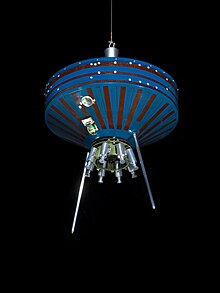Pioneer 2
An attempt to fire the vernier engines on the probe was unsuccessful and the spacecraft attained a maximum altitude of 1,550 km (960 mi) before reentering Earth's atmosphere at 28.7° N, 1.9° E over NW Africa.
Eight small low-thrust solid propellant velocity adjustment rockets were mounted on the end of the upper cone in a ring assembly which could be jettisoned after use.
The total mass of the spacecraft after vernier separation but before injection rocket firing was 39.5 kilograms (87 lb).
The scientific instrument package had a mass of 15.6 kg (34.4 lb) and consisted of an STL image-scanning television system (which replaced the NOTS (Naval Ordnance Test Station) image scanning infrared television system on Pioneer 1), a proportional counter for radiation measurements, an ionization chamber to measure radiation in space, a diaphragm/microphone assembly to detect micrometeorites, a spin-coil magnetometer to measure magnetic fields to 5 microgauss, and temperature-variable resistors to record spacecraft internal conditions.
The spacecraft was to be spin-stabilized at 1.8 revolutions per second, the spin direction approximately perpendicular to the geomagnetic meridian planes of the trajectory.

